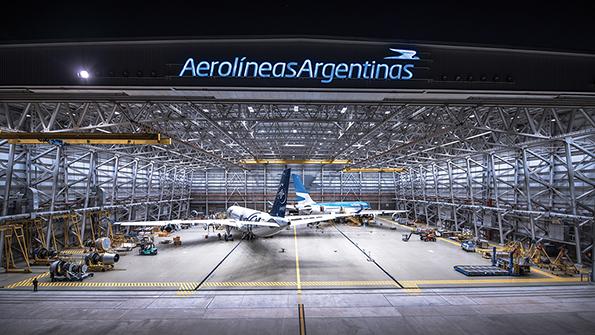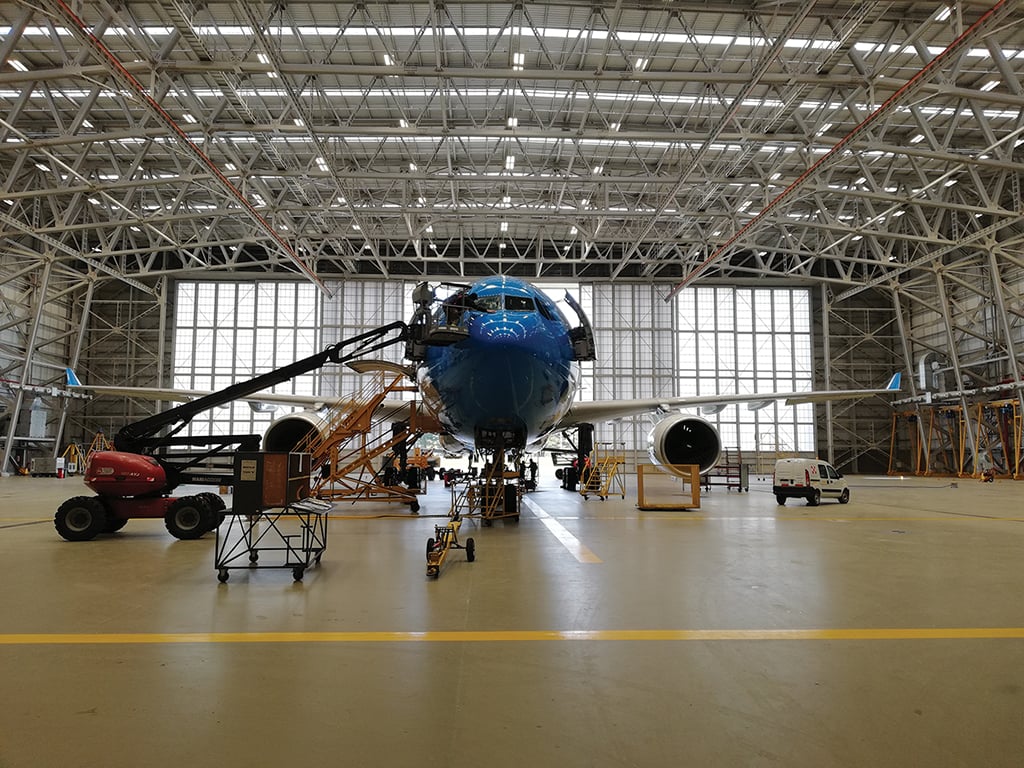
Aerolineas Argentinas plans to grow its business as a third-party maintenance provider.
Diego Georgiadis, the airline’s technical director, talks with James Pozzi about what its aftermarket business looks for in MRO partners and why it aims to tap into specializations on certain aircraft and engine types to drive more third-party business.
How is the commercial aviation market recovering in Argentina since the outbreak of COVID-19 three years ago?

Credit: Aerolineas Argentinas
The recovery in Latin America has been strong over the past year. Right now, we are at about 90% of activity in comparison to the pre-pandemic year of 2019. This is excellent, considering the recovery needed from the economic crisis for the industry brought on by COVID-19. Things are also looking positive for the airline. Domestic air travel activity is increasing faster than anticipated over the past two years, so recovering the fleet for this purpose was a complicated process at times. Overseas travel is also increasing.
In 2020, before the crisis, the company wanted to transform our technical division, and this is still the aim. Some of these transformations included selling our brand as an MRO around Latin America. [Another] key milestone was to discuss union arrangements with our mechanics. We signed a very important agreement with the mechanics union in December that will enable us to allow more flexibility while still working to industry standards.
How has the maintenance team worked to help the airline reactivate its fleet?
Our widebody fleet is composed of eight Airbus A330 aircraft, which we are looking to grow to 10 over the next few months. Over the past three years, it has mostly remained active, so there wasn’t much need for our maintenance teams to do reactivation work on them. At the peak of COVID-19, several of these widebody aircraft were used for recovering passengers and transporting medical equipment for the vaccination process. Our Embraer fleet—22 of which we inherited from our merger with Austral in 2020—presented some challenges, as all of those aircraft with almost the same activity were grounded at the same time. When the COVID-19 crisis hit, which resulted in reduced technical operations for these aircraft, it was difficult to recover and get the necessary maintenance done. For example, structural inspections were due at a similar time on all the aircraft.
Three of these aircraft are still in storage, awaiting a maintenance slot because it has been a very slow recovery. Much of our maintenance is done by our technical teams in-house, but for this aircraft type we had to outsource four E190s last year and four more this year, as we don’t yet have the required capability for that. The Boeing 737 fleet is different, as we changed our maintenance plans for that aircraft in 2019, which saw us manage the inspections and heavy checks in different phases. Almost all of those aircraft had returned to service by early 2022.
What is your strategy for insourcing and outsourcing maintenance?
For airframes, we try to keep most of it in-house, and the Embraer maintenance being outsourced was a unique situation as we wanted to keep aircraft available for commercial use. We don’t expect to send any other aircraft to third-party MROs this year, as those checks will be done in-house. Around 95% of our maintenance is done in-house, with the other 5% outsourced.
What does Aerolineas Argentinas look for in an MRO partner, and is it exploring new partnerships?
Geographically, Argentina, and the South America region, is very far away from the rest of the world, so being in this location can impact logistics and lead times. So finding partners who can ensure short turnaround times is important. Of course, quality is a big driver when seeking our partners—this is a non-negotiable asset for us. Long-term relationships are also important, given the fluctuating economy of Argentina. We are seeking partners to work with in several areas, including improving our back shop and engine workshop capabilities. We are also analyzing the possibility of recovering our old test cell, which was previously used for JT8D engines powering MD-80 aircraft many years ago. We’re trying to find a partner to potentially upgrade our test cell for current engine types. We have a good capability for CF34 and CFM56 engines, and upgrading the test cell could lead to improvements in our engine shop.
However, our location far away from regions such as North America, Europe and Asia-Pacific would mean challenges related to turnaround times and logistics costs. We need to assess whether this move would be economically viable. Also, we are speaking to an MRO provider about potentially partnering to set up a parts pooling location in Latin America.
We’re also looking to grow airframe heavy maintenance for other airlines and grow our business as a third-party provider as we continue to grow our efficiency and develop business cases for our capabilities. This growth would target the Latin America region, where we see there is a need for more MRO providers.
How has the MRO supply chain held up over the past few years, considering various global events and crises?
Logistics costs are rising. In the supply chain, we share the same problems with other Latin American airlines. Together, we’ve discussed what OEMs can do to help us. From our side, in our procurement and materials management, we increased communication and permanently monitored the situation with our suppliers. We had to maintain and even increase our stock of certain component types, too. But overall, it’s a tough environment right now. There are issues with logistics and distribution for parts from the U.S. to Latin America, and turnaround times are increasing. This has especially had an impact on our annual heavy maintenance plan. However, over time, these will ease, and I expect them to normalize by the middle of next year. One solution we’ve explored to ease some supply chain pressures is changing our policies toward [parts manufacturer approval (PMA)] parts. Aerolineas Argentinas has a restrictive policy toward PMA, but we are looking for more flexibility and a potential agreement between OEMs and PMA manufacturers. We’ve started to use PMA parts for our interiors work initially, and with approvals, we’d like to start using more PMAs in our fleet.
What technologies has Aerolineas Argentinas invested in for maintenance?
We rolled out AMOS software across our operation four years ago to manage all of our technical operations. We are at about 80% usage of the system. Predictive and preventative maintenance are technologies we are very interested in utilizing. Using all of the tools we have available to do line maintenance differently is a goal of mine. This will first be used for the Embraer fleet, as this predictive maintenance could help overcome problems we have faced in the past few years. We have also introduced the Airbus Skywise platform across the entire fleet. The idea is to use this to help with fleet reliability.

Credit: Aerolineas Argentinas
About Aerolineas Argentinas
History: Aerolineas Argentinas was founded in 1949 by the country’s government and commenced operations the following year. It went into private ownership in 1990, after being acquired by a consortium led by Spanish airline Iberia. The carrier has again been under the control of Argentina’s government since 2008, after regaining ownership from its former Spanish consortium owners Grupo Marsans, which had purchased a majority stake in the carrier in 2001. Further organizational change occurred in late 2020, when Aerolineas Argentinas merged with its subsidiary airline Austral. The airline’s MRO division, Aerolineas Argentinas Tecnica, has operated for more than 70 years and services the fleet of the Argentinian flag carrier along with third-party operators. The technical division of Aerolineas Argentinas employs some 2,300 people.
Fleet: Aerolineas Argentinas’ fleet consists of eight Airbus A330-200s (expected to increase to 10 this year), eight Boeing 737-700s, 29 737-800s, seven 737 MAX-8s and 26 Embraer 190s. Delivery of two 737-800F aircraft is expected this year.
Capabilities: Base maintenance up to D Checks, structural repairs of fuselage and composites, major and minor cabin modifications, line maintenance, continuing airworthiness management organization services and technical training. Aircraft serviced include the Airbus A330, Boeing 737NG and MAX aircraft and Embraer 190. Selected engine services are provided for CFM International CFM56-7B, General Electric CF34-10E and CF6 and Pratt & Whitney PW4000 models. The airline has about 20 components shops at its Buenos Aires sites.
Facilities: Aerolineas Argentinas’ main bases, composed of eight maintenance hangars, are at two airports in Buenos Aires—four each at Ezeiza International Airport and Aeroparque Internacional Jorge Newbery. These facilities offer more than a dozen narrowbody and widebody maintenance bays between them. The airline also operates line stations across Argentina and the wider South America region, including Brazil, Chile, Colombia, Paraguay, Peru and Uruguay.





